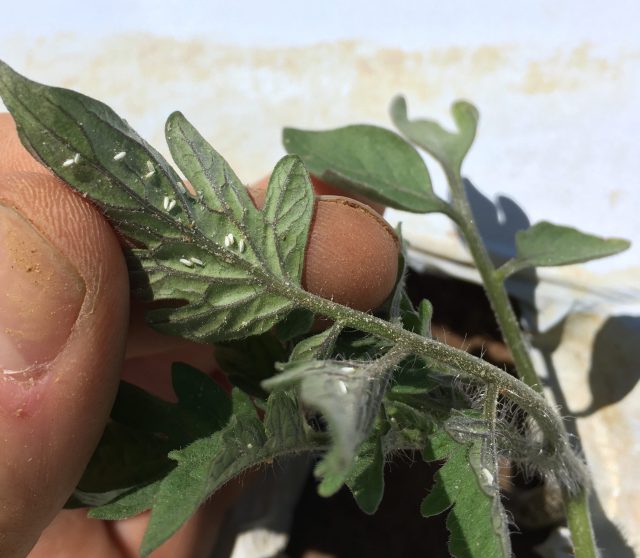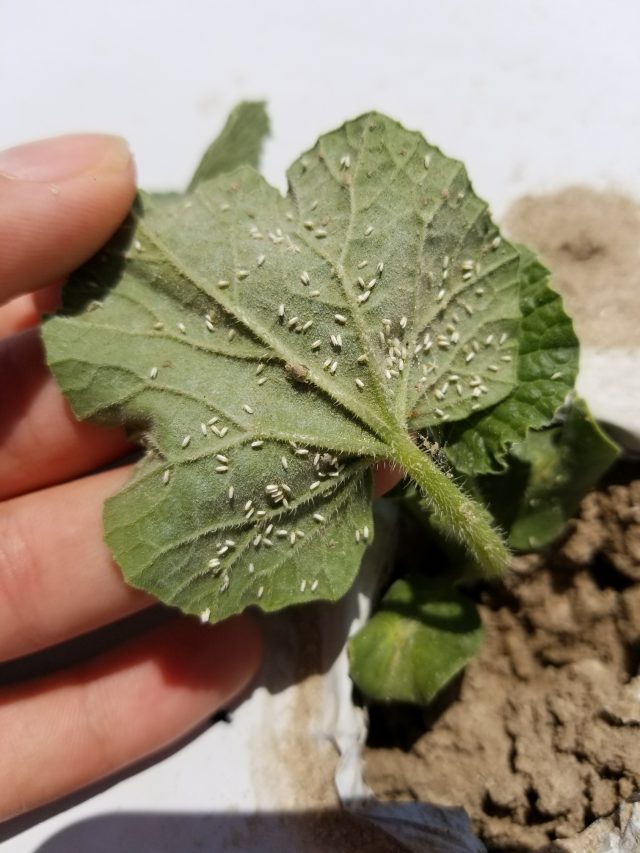
As if the fall season wasn’t challenging enough from a pest and disease perspective, throw in a hurricane and it gets much worse. Luckily, the storm missed most of the Panhandle. Tomato and cucurbit producing areas in Gadsden and Jackson counties likely saw the greatest impacts from Hurricane Irma. The biggest problem was the wind and wind driven rain. It doesn’t take much rain when you’ve got 40-60 mph winds to drive that water into leaves. This factor combined with the plants getting beaten around can create quite a bit of leaf damage. These damaged areas can be just the foothold that some plant diseases need to get started in a big way. The first thing we noticed was bacterial spot of tomato moved into most fields, and in fields where it was already established, it moved up the plant. This is a pretty common progression with this disease; yellowing begins in the lowest leaves near the ground, and it progressively marches up through the canopy. Rain and leaf wetness exacerbate bacterial spot and can lead to complete blighting or defoliation of the plant (Figure 1).
The other major pathogen of concern for the fall is target spot, a fungal disease that typically shows up later in the season when the weather cools off some. Target spot also has the potential to get started in leaf tissue damaged by the wind and rain from Hurricane Irma. Producers should stay on a tight spray schedule, especially in fields that have more damaged foliage from the storm. A link to UF/IFAS tomato production recommendations is provided at the end of this article.
If you haven’t noticed the whiteflies yet, then you haven’t been outside since about July. And it’s not just in and around vegetable crops, they’re everywhere. I had a psychic moment and was concerned about them in April (seeStart Preparing Now for Whiteflies this Fall in Vegetable Crops) and my premonitions have certainly played out. Whitefly populations have been exceptionally high since producers started setting fall plants. Most tomato and cucurbit seedlings had whiteflies on them within hours of planting (Figures 2&3) which means they will need to be managed for 90 days or so.


For tomato producers the two major concerns are Tomato Yellow Leaf Curl Virus (TYLCV) (Figure 4) which is transmitted by whiteflies, and irregular fruit ripening (Figure 5) which is caused by whitefly feeding. TYLCV is already bad and it is still a long way to harvest. Unfortunately when plants are infected with TYCLV early they essentially stop growing and likely won’t produce any fruit. We have fields locally that have 40% infection with another 30 days before harvest.


There are several links below to information about whitefly management. It is very important to rotate pesticide modes of action. It is tempting to rely heavily on neonicotinoids, but if we want to maintain these chemistries for the future, alternative modes of action should be used. We have wondered for the last several years whether TYLCV will become established and be a consistent problem in North Florida and South Georgia, and as of now it appears that during the fall it will be. If we continue to have mild winters it is likely that high whitefly populations may become normal during the fall, and it will be recommended that tomato growers rely heavily on TYLCV resistant varieties. These varieties are listed in the tomato production guide below.
Whiteflies also pose a serious problem for cucurbit and bean producers. Much like tomato, they transmit viruses, Cucurbit Leaf Crumple Virus and Bean Golden Yellow Mosaic Virus. Whiteflies cause fruit quality issues such as light colored beans or squash from feeding damage. The other major pathogen to be on the lookout for is Downy Mildew. This generally comes on when conditions cool off, enabling the fungus to rapidly move through fields, especially when we get persistent foggy mornings that keep leaves wet for multiple hours. A link to the cucurbit production guide is also below.
In summary, take action, now. These pests and pathogens were likely already present in most fields, and their progression may have been hastened by Hurricane Irma. It is critical when using chemical control options for all the pests and pathogens listed above that modes of action are rotated. These codes are listed in their respective production guides as well as on the pesticide labels. Chemical control options are generally limited, so it is important that we are good stewards of the tools that we do have.
UF/IFAS Publications and Resources referenced in this article:
-
Start Preparing Now for Whiteflies this Fall in Vegetable Crops
-
Chapter 18.Tomato Production
-
Unusual Outbreaks of Sweetpotato Whiteflies in the Panhandle
-
Chapter 7. Cucurbit Production
 0
0
